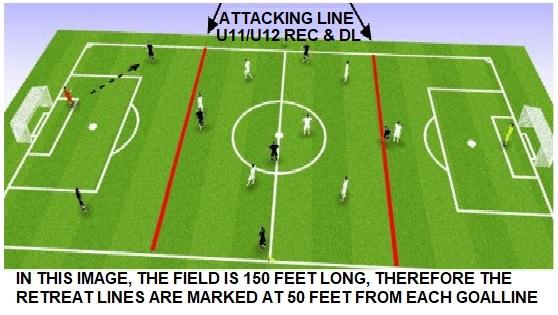U11/12 Attacking Line Rule
In these matches, offside is to be enforced only within the attacking third of the playing area on each side of the pitch.

Officials are reminded that there is no "offside line" (as a blueline is used in hockey) but rather the offside rule is applied in the same manner as it is in standard 11 v 11 outdoor soccer with the modification that it is only applied in the attacking third of the field of play. Keeping that in mind, the key moment of judgment is when the ball is played. Therefore it is possible for an individual to receive or touch the ball within the attacking third of the field but not necessarily be offside provided that at the moment the ball is played, they are outside of the attacking third of the field of play.
In order for a referee to be able to consider if a player may be offside, the player must satisfy two initial requirements at the moment the ball is played:
1. Being within the attacking third of the pitch
2. Being in an offside position.
At that point, the referee can determine if the player is:
- interfering with play or
- interfering with an opponent or
- gaining an advantage by being in that position
To aid officials and to better explain the application of offside in these matches, we would like to present the following diagrams for examination:
1. Offside Scenario #1 - Attacker in offside position within the attacking third of the field of play.

Decision: Offside - In this scenario, an attacker (red) is in an offside position because he is behind (closer to the goal line) the second to last defender. When the ball is played to him, offside can be enforced as he was in that offside position within the attacking third and now interfering with play.
2. Offside Scenario #2 - Player making the pass and player receiving pass both within Attacking third of the field and behind second to last defender.
Decision: Offside - In this scenario, both attacking players (red) are behind the second to last defender. They are also within the attacking third of the field. When the attacker on the left plays the ball to the attacker on the right, offside is called as he is within the attacking third of the pitch, in an offside position, interfering with play and ahead of the ball.
3. No Offside Scenario #1 - Player making the pass and player receiving pass both within Attacking third of the field and behind second to last defender.
Decision: No Offside - In this scenario although both attackers (red) are within the attacking third of the pitch and behind of the second to last defender, the attacker who receives the ball (right) is not considered to be in an offside position as he is behind the ball at the moment it is played to him. Therefore as he does not meet both requirements of being in the attacking third and being in an offside position, the referee cannot consider offside.
4. No Offside Scenario #2 - Both attackers are behind the second to last defender outside the attacking third of the field.
Decision: No Offside - In this scenario, both attackers are behind the second to last defender. The attacker on the left plays the ball forward to his teammate (center) who is in front of the ball. Here, although the center attacker is in an offside position, as he is not in the attacking third of the pitch at the moment the ball is played, the referee cannot consider penalizing him for offside.


